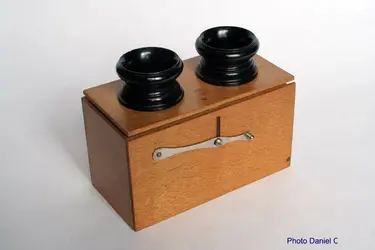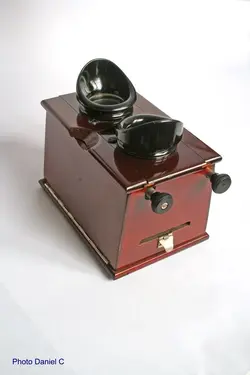Dany
No longer a newbie, moving up!
- Joined
- Dec 13, 2011
- Messages
- 320
- Reaction score
- 651
- Location
- Paris
- Can others edit my Photos
- Photos NOT OK to edit
Please find hereafter some of the stereoscopes and photo viewers from my collection
Some of them were low cost items, widely sold, and sometime simply made of cardboard.
Some others were more expensive pieces made from fine woods
I must confess that I find all of them equally interesting.
I start with two cheap cardboard stereoscopes made in France . One by Brugiere, the other one by Mattei
Focusing is made by sliding the rear part of the body inside the front part


Other stereoscopes were metal made. This one looks like brass spectacles . It was sold by Richard Freres

This other one looks like binoculars (unknown maker)

Another one with a strange design, made by Mattei

This Holmes type is hand held by means of a handle at the bottom. Collectors are calling "Mexican" this type of stereoscope. I still don't know why.

Wood stereoscopes are generally more sophisticated... Well, not all of them if we consider this very simple one made from teak wood. The lever is used for focusing

Some stereoscopes were fitted with a wood door with a mirror installed in the inner face of the door. This system, when the door was opened, reflected the light for a better view of the opaque photos.

This one is technically enhanced. A knob is used to adapt the distance between the lens to the distance between user's eyes. The other knob is used for focusing. A special cut is made on the edge of the lens board for the nose of the user.

A more simple one was made by Mattey and offers only one knob for focusing.

Some viewers were fold when unused and are called graphoscopes.
This one is very simple and cannot be used to look at stereo images:

This other one is made with blackened wood. The front shows the Inscription "Souvenir de Paris".
It has probably been sold to visitors of the Paris international exhibition in 1900.

This graphoscope allows for viewing both simple and stereo images

This last item is rare . It has been made by Papigny and Mattei and was named "stereotelescope"
It was used to see stereo images projected on screens.


Some of them were low cost items, widely sold, and sometime simply made of cardboard.
Some others were more expensive pieces made from fine woods
I must confess that I find all of them equally interesting.
I start with two cheap cardboard stereoscopes made in France . One by Brugiere, the other one by Mattei
Focusing is made by sliding the rear part of the body inside the front part


Other stereoscopes were metal made. This one looks like brass spectacles . It was sold by Richard Freres

This other one looks like binoculars (unknown maker)

Another one with a strange design, made by Mattei

This Holmes type is hand held by means of a handle at the bottom. Collectors are calling "Mexican" this type of stereoscope. I still don't know why.

Wood stereoscopes are generally more sophisticated... Well, not all of them if we consider this very simple one made from teak wood. The lever is used for focusing

Some stereoscopes were fitted with a wood door with a mirror installed in the inner face of the door. This system, when the door was opened, reflected the light for a better view of the opaque photos.

This one is technically enhanced. A knob is used to adapt the distance between the lens to the distance between user's eyes. The other knob is used for focusing. A special cut is made on the edge of the lens board for the nose of the user.

A more simple one was made by Mattey and offers only one knob for focusing.

Some viewers were fold when unused and are called graphoscopes.
This one is very simple and cannot be used to look at stereo images:

This other one is made with blackened wood. The front shows the Inscription "Souvenir de Paris".
It has probably been sold to visitors of the Paris international exhibition in 1900.

This graphoscope allows for viewing both simple and stereo images

This last item is rare . It has been made by Papigny and Mattei and was named "stereotelescope"
It was used to see stereo images projected on screens.



![Underwood & Underwood - Stereoscope [212] 020.webp Underwood & Underwood - Stereoscope [212] 020.webp](https://www.thephotoforum.com/data/attachments/176/176112-64c99624ff4430702c14369b63370b3c.jpg?hash=mucBE4H6YG)


![[No title]](/data/xfmg/thumbnail/42/42351-b976e32171d0405397bf5237bc4b902e.jpg?1734176880)


![[No title]](/data/xfmg/thumbnail/35/35867-0c74c728d92f908264af585fd93bd36c.jpg?1734167586)




![[No title]](/data/xfmg/thumbnail/39/39544-f587cf14279888b81e3b51750534ae22.jpg?1734173699)
![[No title]](/data/xfmg/thumbnail/42/42349-fa3065c4e047f0114ec8715d9168dff9.jpg?1734176875)
